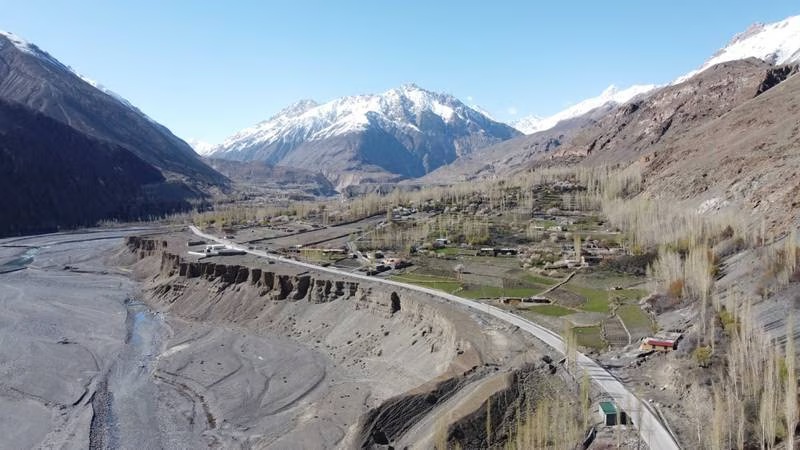Katy Gillett
While crossing a country by plane or train can be fun, nothing beats hitting the open road and experiencing everything it has to offer by car or camper van.
Not only can you see the landscape changing as you pass, but you can also make whatever pit stops you like along the way, getting up-close with a nation’s – or even a whole continent’s – most famous attractions, as well as discovering its best-kept secrets.
These are some of the world’s best road trips that are epic in length and beauty.
The Carretera Austral
Location: Chile
Length: 1,240km
Best time to go: November to March
:quality(70)/cloudfront-eu-central-1.images.arcpublishing.com/thenational/5DL6NRJSUJC7HC63MAQ7Z5B554.jpg)
Discover Patagonia’s majesty via a two-week journey along Chile’s Route 7, also known as the Carretera Austral. The road stretches from Puerto Montt to Villa O’Higgins, weaving through volcanoes, rainforests, glaciers and ancient marble caves.
It’s unpaved, so it can be a pretty bumpy drive – and even more so outside of summer, when severe weather is common – but it’s worth any discomfort to hike through the Valdivian temperate rainforest or kayak through the network of glacial caves known as the General Carrera Lake’s Marble Chapels.
Elsewhere, it’s possible to go rafting on the Futaleufu River or try canyoning on the fjords of Pumalin Park, where you can also camp at the foot of isolated waterfalls. There are the Puyuhuapi hot springs, where travellers can rest and rejuvenate before sailing to the Las Hermanas islets over the Palena river to spot Chinook salmon, sea lions and dolphins.
In Villa O’Higgins, drivers will need to turn around and head back north, but anyone who chooses to travel by bike or public transport can go on and cross the lake to explore Argentina, where you could set off on the country’s famous Route 40 (more on this below).
Karakoram Highway
Location: China-Pakistan
Length: 1,300km
Best time to go: May to October (excluding July and August)
:quality(70)/cloudfront-eu-central-1.images.arcpublishing.com/thenational/G6B24TE2ZVEPBNR2KYDBQ6P5SI.jpg)
While you can technically drive this in about two days, most experts recommend taking two weeks to truly discover the beauty of the Karakoram Highway. It takes travellers from Islamabad in Pakistan to Kashgar, China, once one of the most important cities along the ancient trading route known as the Silk Road.
Also known as the China-Pakistan Friendship Highway, and even the Eighth Wonder of the World, this is one of the highest paved roads on the planet. It was completed in 1978 after nearly 20 years of construction by Chinese and Pakistani workers.
Rugged terrain, hairpin turns and the potential for steep drops makes this a journey for the brave and adventurous. Parts of the road are also closed during winter due to heavy snow. Jaw-dropping views, snow-capped mountains and unspoilt valleys, however, make this an incomparable trek.
One of the main highlights is Fairy Meadows, a national park where you can soak in incredible views of Nanga Parbat, the world’s ninth highest peak and one of its deadliest (yet most beautiful) mountains. Then there’s the remote Hunza Valley, which is surrounded by the Karakoram Mountains, where you can also see glaciers and alpine lakes, as well as come across indigenous people with a culture and traditions unlike anywhere else.
On the Chinese side, there’s the stunning teal-coloured White Sand Lake, a huge water reservoir surrounded by sand dune mountains, and plenty more diverse sights to behold.
Ring Road
Location: Iceland
Length: 1,332km
Best time to go: April to October
:quality(70)/cloudfront-eu-central-1.images.arcpublishing.com/thenational/YF4OXKCA45DANFIVZICEDBG7LQ.jpg)
Iceland, the Land of Fire and Ice, where volcanoes sit near glaciers, is a place like no other. And it’s best experienced by driving its Ring Road, which takes you around the entire island to tick off every “must-see” on the bucket list.
As there’s so much to do and see, experts recommend taking between seven and 10 days to complete it. Visitors can do this by booking a guided tour or renting a car or camper van and doing it alone.
If you fly into Reykjavik, it’s worth spending some time in the country’s capital. One of the more popular activities here is a dip in the Blue Lagoon, where people like to soak in the warm geothermal waters before heading off on their road trip.
From there, there are countless highlights, from the Golden Circle – which takes in the geothermal area Geysir, the national park Pingvellir and the Gullfoss Falls – to the black sand beach of Vik and the otherworldly area of Lake Myvatn, home to Krafla volcano and the pseudo-craters of Skutustadagigar that were formed by gas explosions more than 2,000 years ago.
While the roads are generally in good condition, there are some narrow passes, blind summits and a stretch of gravel, so go easy, especially if you visit during winter, when heavy snow can affect your journey. It’s also worth noting that driving off-road is strictly prohibited and heavily fined.
Route 40
Location: Argentina
Length: 5,194km
Best time to go: November to February
:quality(70)/cloudfront-eu-central-1.images.arcpublishing.com/thenational/AFVGHINXBZG4LGUQ3XFYOWKFZ4.jpg)
Ancient forests, deep canyons, lava fields, salt flats and the remote plains of Argentina’s Patagonian steppe are a few of the highlights drivers can expect to see when travelling Ruta 40, also known as Ruta Nacional 40 or La Cuarenta (the 40). It’s one of the longest highways in the world, stretching from the Bolivian border to Rio Gallegos, the southernmost port of the country, running parallel to the Andes. It’s as ubiquitous to Argentina as Route 66 is to America, having inspired authors and songwriters for decades.
If you begin in the north, you’ll reach one of the best highlights of the trip early on – Siete Lagos, which translates to Seven Lakes, a route that spans three national parks and two provinces, where the turquoise hues of the waters are mesmerising.
Another highlight is Piedra Parada, a prehistoric-looking desert rock-climbing area that’s home to caves and crystals – and well worth the slight detour from the route.
After that, there’s a 16-hour drive through desolate lands you need to push through to reach the Unesco World Heritage Site of Los Glaciares National Park, home to the glaciers of the Southern Patagonia Ice Field. Here, you can literally see big chunks of ice sliding off and noisily splashing into the glistening waters below.
Another famous detour worth taking is to Cueva de las Manos (Cave of the Hands), where you can see perfectly preserved 13,000-year-old cave art and the rugged landscapes of the Rio de Las Pinturas canyon.
Highway 1
Location: Australia
Length: 14,500km
Best time to go: Depends on your direction
:quality(70)/cloudfront-eu-central-1.images.arcpublishing.com/thenational/5DWNEMB37VCK7DD5QNDP2WZTIM.jpg)
You could spend months driving Australia’s Highway 1, also known as The Big Lap, which takes drivers around the entire country and through every state except Tasmania.
It’d be impossible to encompass everything this journey offers in a few hundred words, as it takes in most major cities, quaint coastal towns, bustling and isolated beaches, and plenty of indigenous wildlife. If we are to condense it, however, a few major highlights – and absolute must-sees – include, naturally, the Great Barrier Reef; The Great Ocean Road on Victoria’s southern coastline; the Unesco-listed Kangaroo Island; the orange-and-black-striped sandstone formations known as Bungle Bungle Ranges; and Kosciuszko National Park in the Snowy Mountains region.
If you plan to drive all day, making brief overnight pit stops, you could complete your trip in two weeks (although the world record for the fastest lap is just under six days). But if you really want to soak up Australia in all its glory, you could take three months or preferably even longer. Obviously, this will take weeks of careful planning, but it’s the kind of once-in-a-lifetime trip eager road-trippers dream about.
One of the best ways to do it is in a camper van, or at least a roomy mini van, so you don’t have to find places to stay every night. You can travel in a clockwise or anti-clockwise direction, but experts suggest you decide based on the time of year you want to go – so you can avoid scorching summers and torrential downpours.
Pan-American Highway
Location: North and South America
Length: 30,000km
Best time to go: Depends on where you go
:quality(70)/cloudfront-eu-central-1.images.arcpublishing.com/thenational/3A3I7FLDCRCN3MD6KXNG3GTFBA.jpg)
Forget Route 66, the real all-American road trip is about 10 times as long and is yet another once-in-a-lifetime trip that could take months. We’re talking about the Pan-American Highway, which the Guinness World Records has designated as the world’s longest motorable road.
It was originally conceived in the early 1920s as a single route but it grew into a network of roads that passes through 14 countries, stretching from Alaska and Canada through the US and on to Chile, Brazil and the southernmost tip of Argentina.
It’s possible to break this trip down into sections or span the entire length, which on average can take about nine months to two years, depending on how much time and money you have.
In some parts it can be fairly treacherous, with extreme weather and landslides to conquer, and areas of criminal activity. There’s also one part that’s impossible to drive through for environmental and political reasons. That’s a 100km overland route called the Darien Gap, which goes across the border between north-western Colombia and south-eastern Panama. Anyone wanting to travel the entire length of the Pan-American Highway usually bypasses this by flying or sailing, and you can ship a vehicle by boat.
If you do take the time to do it all and plan it well, you’ll be able to immerse yourself in myriad landscapes, climates and cultures across North and South America, and see some of the continents’ best attractions, from Machu Picchu in Peru to the jungles of Costa Rica and the wilds of Alaska.
Courtesy: thenationalnews







